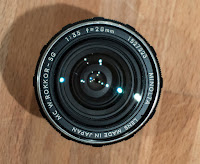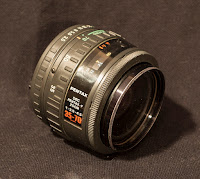Cost: 18$ - with Minolta SRT101 body (average market price $30)
Again a good find from a Salvation Army Thrift Store.
It's hard to do a photo blog if it is dark when you leave home, and dark when you go back home. And even worse if it has rained for a average of 28 days per month, for the last 2 months. So, it's the season for some night photography!
I really liked shooting with this lens. Butter smooth focus ring and even more smooth aperture ring (maybe a tad to smooth). And I really like the feel and look of the lens. Fully made of metal, resulting in a very solid feel, nicely detailed finish with a sophisticated looking aluminum aperture ring. Easy to find the aperture and focus ring, even in the dark when just working on touch.
Nice to use, easy to focus. It's not a fast lens with a 3.5 minimum aperture, so not that good to capture active scenes, but the slow speed makes it useful for night ocean landscape photography as the lengthy exposures makes the water look velvety.
The APS-C crop factor of 1.5 results in 42mm, providing a nice crop for city skylines from a reasonable distance.
However, that's where the good qualities stop. As a pixel-peeper, it becomes obvious that the lens is lacking in true sharpness, especially in the lower to mid range f-stops. Slightly better when fully closed, but not as sharp as most of my other lenses within that range. But, if you are not a pixel-peeper, you can take some really nice pictures.
This the second generation of the MC W.Rokkor-SG 28mm 1:3.5. with a smaller filter size than the original. In general, most users agree on sharpness problems. The 1:2.8 version of the 28mm of the same era had a much better reputation.
I will have to take this lens out again during day light some other time, to evaluate the color and bokeh features.
Rokkor: The Rokkor and Auto Rokkor where Minolta's first generation of lenses, with Auto Rokkor being the more expensive one with novel automatic apertures. The Rokkor line was fully manual but priced lower. Quality of the Rokkor lenses was top notch though and remained as the entry level Minolta lenses long after the Auto Rokkor line was replaced.
W.Rokkor: Wide Angle Lenses with SR-Mount
SG: The letter code after the Rokkor name show the optical design of the lens. The code designated the number of groups and elements within a lens:
First Letter (no. of groups): T=3; Q=4; P=5; H=6; S=7; O=8; N=9.
Second Letter (no. of elements): C=3; D=4; E=5; F=6; G=7; H=8; I=9; J=10; K=11; L=12.
MC: Stands for Multi Coated. The MC Rokkor lenses were easily identifiable by the aluminium aperture ring.
Lens Specification:
Focal Length: 28mm
Maximum Aperture: F3.5
Minimum Aperture: F16
Image Format: 35mm
Lens Mount: Minolta SR
Optics: 7 groups, 7 elements
Blades: 6 blades
Focussing: Manual
Minimum Focus: 0.6m
Maximum Magnification: ?
Filter Size: 55mm
Weight: 245g
Length: 55mm
Production: 1968-1972
Serial Number: 1527223
Samples:






















